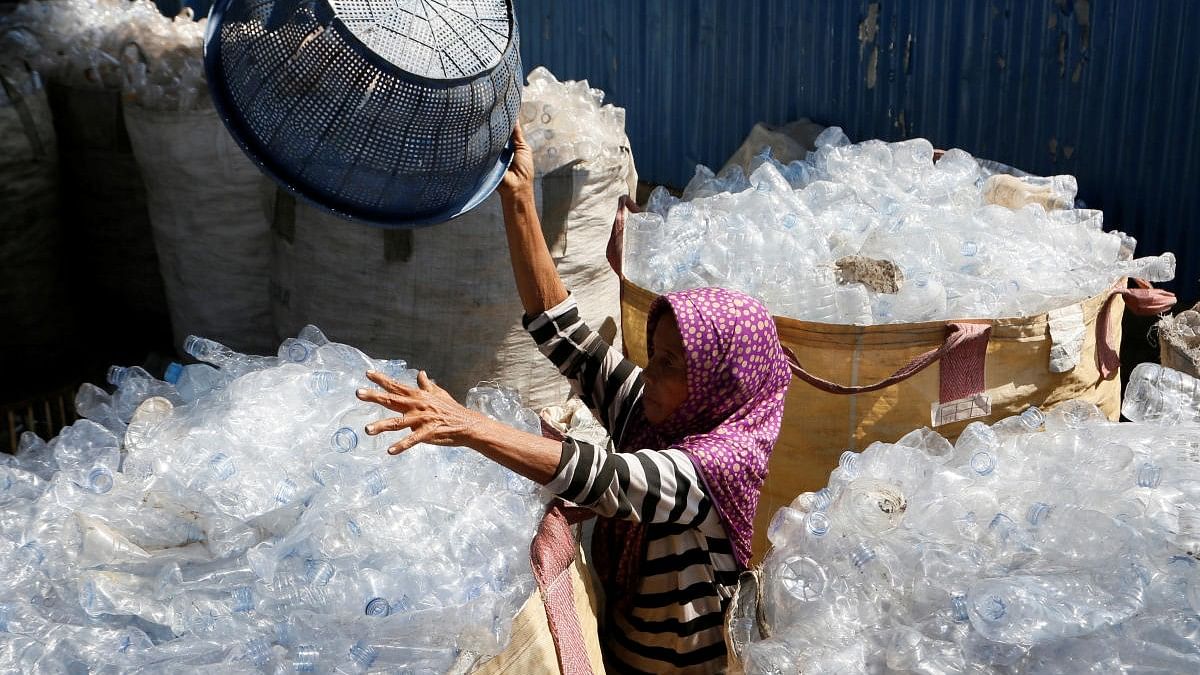
File photo showing a woman dumping plastic bottles for recycling at a facility.
Credit: Reuters File Photo
By Steve Hardman
When it comes to plastic waste, the numbers are alarming. And they’re getting worse.
According to the OECD, 91 per cent of all plastic used goes unrecycled into nature, oceans, landfill or incineration every year— that’s 320 million tons. By 2060, there will be an additional 30 billion tons. Only 5 billion tons are predicted to be recycled.
The world needs a plan to fix its plastic problem. The United Nations has committed to delivering a legally binding Plastic Treaty by the end of 2024. This month, more than 175 governments will convene in Ottawa for the fourth and penultimate round of negotiations of the Plastic Treaty.
The most important thing for the Plastic Treaty to get right is the development of sufficient global recycling capacity to ensure that all plastic used will be recycled and a circular economy will be realized. That’s a colossal industrial undertaking.
The business of plastic recycling is economically fragile at best— and in many ways it is also broken.
At the heart of the challenge is the task of selling the “feedstock” that is produced by plastic recyclers. Right now, buyers of plastic feedstock can choose between virgin plastic or recycled plastic when they make their packaging. If the price of recycled plastic is lower than virgin plastic, buyers switch to recycled plastic. And if the price of virgin plastic is lower, buyers switch to virgin plastic. Regrettably, many companies are more concerned about the price of plastic feedstock than the environmental impact of more plastic.
What makes this switching unpredictable is the fact that the price of virgin plastic is directly related to the price of oil from which it is sourced. If the price of oil drops, so does the price of virgin plastic. If the price drop of oil is material, then the market for recycling plastic feedstock collapses. As such, plastic recycling the world over is essentially held hostage to the price of virgin plastic.
For example, a substantial portion of Europe’s plastic recycling capacity has disappeared in the past two years due to unsustainable trading conditions brought on by the drop in the price of oil. Now imagine you’re an investor or an entrepreneur looking to invest $10 million in an expensive plastic recycling facility. Would you do so knowing that some global event completely unrelated to your business could result in a drop in the price of oil, making virgin plastic cheaper than recycled plastic you would produce?
The answer is clear— and explains why the world has just 9 per cent of the recycling capacity it needs.
Various solutions are being put forth. Some countries demand that companies pay a tax for the amount of virgin plastic they use. Other countries require the use of a certain amount of recycling plastic in packaging.
There is one (big) problem with both the “virgin plastic tax” and the “minimum recycled content” solutions, however: They rely on the market to stimulate the development of a plastic recycling industry. Neither approach helps to directly finance the significant capital requirements of the recycling industry. Where will the money come from to pay for the costly infrastructure required for plastic recycling?
The question is how to get capital investment directly to the recycling industry so it can invest confidently in the equipment, personnel and training necessary to create a dramatically expanded global plastic recycling industry.
Discussions around the Plastic Treaty discussions have so far surfaced very few ideas on this front. Other than a global sinking fund from UN member states, which few taxpayers are likely to be happy about, the draft treaty is eerily silent.
Plastic Collective, the World Bank and Citibank have spent many years developing a scalable financing mechanism to directly address the capitalization of plastic recycling in countries where plastic waste is at its worst and finance options are few. The result is the Plastic Waste Reduction Bond, the first of which was offered in January.
It is a $100 million principal protected bond, with $14 million deployed for two plastic recycling projects in Ghana and Indonesia. The two projects will use the funds to invest in new technologies, equipment, facilities and staff to increase their collection and recycling capacity by 500 per cent over the next three years and process an additional 250,000 tons of plastic waste over the next 10 years.
What makes this transformative is that the projects which receive the money pay it back using plastic credits, with each plastic credit representing a ton of plastic removed from nature and a ton of plastic diverted from landfill. Underlying this financing mechanism is a regulatory framework called the Plastic Waste Reduction Standard, which independently monitors, measures and verifies the environmental impact of the projects.
The net effect of this financing mechanism is that a project’s expected environmental impact over the next decade can be collateralized into an investment today. This can be used to fund major capital expansion in capacity and infrastructure, support ongoing operational cash requirements and invest in the livelihoods and welfare of those who collect waste.
This can change the way that plastic recycling is funded— especially in emerging nations where the plastic problem is at its worst— by putting a value on the environmental and social impact that these projects generate. It can help finance recycling projects that would otherwise be unfinanceable. As delegates convene in Ottawa this month, I hope they embrace the Plastic Waste Reduction Bond is a vital tool to support the goals of the Plastic Treaty.